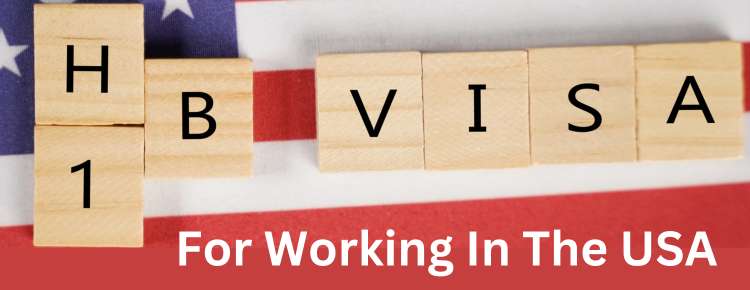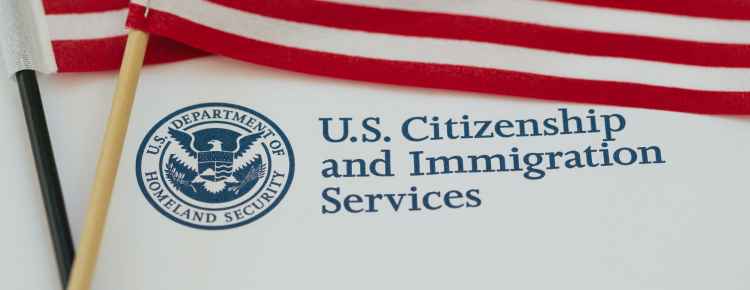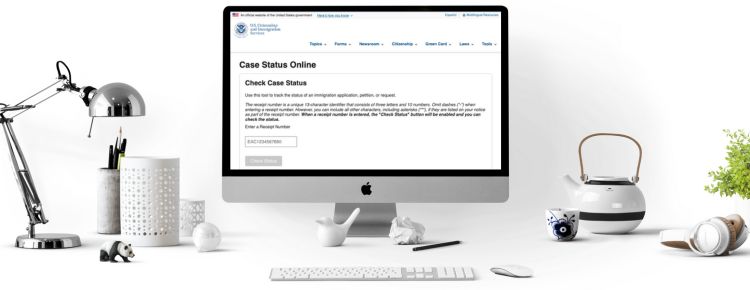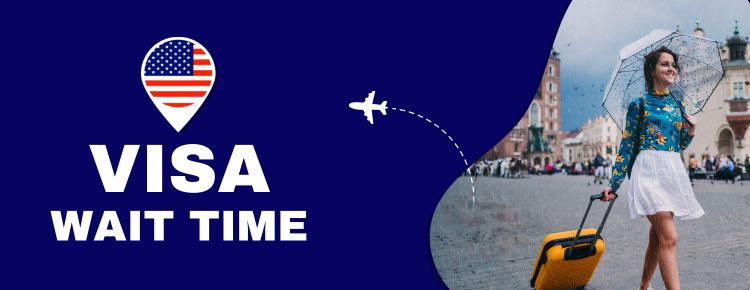H1B Visa Eligibility, Requirements and Application

H1B visa is an employer-sponsored nonimmigrant work visa allowing U.S. employers to hire foreign workers (who are not citizens or permanent residents of the U.S.) for a specific period of time (up to 6 years) having specialty occupations to work in the U.S. The employee must have a bachelor’s degree or equivalent (with the exception of fashion models, of distinguished merit and ability).
In short, it is a temporary work visa allowing U.S. employers to hire foreign workers (with highly specialized knowledge) for specialist jobs.
What Does Employer-Sponsored Mean?
Employer-sponsored means:
- The employer applies on behalf of the prospective H1B employee
- The employer applies through the United States Citizenship and immigration services (USCIS)
What Does Specialty Occupation Mean?
Specialty occupation means that which requires specialized knowledge and skill and at least a bachelor’s degree in that specialty
Under the H 1B:
- The H 1B employer pays the H -1B employee prevailing wage or
- Actual wages (whichever is higher)
What Does Prevailing Wage Mean?
The prevailing wage is the minimum salary that an employer pays to a foreign worker in a similar occupations and geographical area of intended employment.
The prevailing wage is determined by the U.S. Department of Labor (DOL) based on the job duties, education, experience, and skills required for the position.
What Does Actual Wage Mean?
Actual wage is the wage that the employer pays to employees with similar experience and qualifications in similar occupations at the location of the intended employment.
The employer obtains a prevailing wage determination from DOL before filing an H-1B petition with the USCIS.
What Kinds Of Specialty Occupations Qualify for H-1B Status?
The minimum requirements for entry into the occupation in the U.S. on H 1B specialty occupation requires theoretical and practical application of a body of highly specialized knowledge, a bachelor’s degree or higher degree in the specific specialty or its equivalent
Some of the specialty occupations qualifying for the H-1B status include but not limited to: chemistry, architecture, engineering, statistics, biotechnology, computing, physical sciences, medicine, journalism. doctor, dentists, physiotherapists, nurses, education, law, accounting, economics, research, technical writing, theology, business specialties and art
The minimum requirement for the occupation to qualify for H-1B status is A bachelor’s degree.
Depending on the job requirement an advanced degree (master’s degree or Ph.D.) may be necessary.
What Is The H1B Visa Used For?

- The H1B visa is a nonimmigrant visa
- It is used by businesses and organizations in the U.S.
- These businesses and organizations employ foreign nationals with preferred knowledge, qualifications, and expertise in a role.
- The petition is filed with the USCIS, along with the requisite fee
Is There A Minimum Salary Paid For A Job In H-1B Status
Yes, there is a minimum salary paid to H-1B employees on a H-1B status.
The employer hiring the H-1B worker proves with the help of documents and then certifies to the U.S. Department of Labor (DOL) that it will pay the Employee
- The prevailing wage or
- The actual wage
- Whichever is higher
H-1B Visa Eligibility
To be eligible for the H1B visa category, you need:
- Proof of your 4 years bachelor’s degree or equivalent degrees
- A valid job offer (requiring specialist knowledge) from your U.S. employer
- Your employer must prove there is a lack of qualified U.S. applicants in the U.S. for the role
Steps To Be Followed By Foreign Workers To Apply for H1B Visa
Here are the steps to apply for the H1B visa:
- Verify to make sure you qualify for the H1B visa
- Find a petitioner (by applying for a job in the U.S.)
- Get the petitioning initiated (by the employer)
- Apply for the H1B visa in your home country (at the nearest U.S. Embassy/Consulate)
Start And End Dates
Before applying for the H-1B visa you must be aware that there are key dates, processing times, and limitations involved in the process. let us look into these aspects:
USCIS fiscal year starts on October 1 of each year so all visas must be approved to begin working
- Employment starts on October 1 (one) of each year for H1B visa roles
- You can enter the U.S. 10 (ten) days prior to your employment contract begins
- Your visa begins the first day you enter the United States
- Your visa lasts for an initial 3 (three) years (maximum 6 years)
- Every H1B visa role end on September 30, (the year your visa expires)
Processing Time For An H-1B Visa
This can be broken down into stages
- The window opens in April
- To start work in October, Apply as close to the window opening in April
Selection Process For The H1B Visa
The demand for H1B visas is very high therefore there is a limit to the number of visas that can be issued each year. There are only 65,000 visas available for regular cap, and only 20,000 visas for master’s cap (having a master’s degree or higher)
- The process of selection is a computer-generated random lottery selection process.
- Applicants are approved using a computer-generated random lottery selection
- USCIS chooses the allowed petitions randomly (if the applications exceed the visa cap)
What Is The H-1B Cap?
As per the current regulations, the cap for H-1B is set at 65,000 H-1B visas for the entire USA.
- Cap refers to the limit of visas allowed per federal fiscal year.
- A fiscal year begins on October 1st and ends on September 30th of the following year.
Exemptions To The Cap
There are exemptions to the limited visas. You may qualify if you are from any of these fields:
- Government research organization
- Non-profit organizations associated with higher education institutions
- Higher education Institutions
- Nonprofit research organization
Even if your petition is initiated, you still must adhere to the processing time
How Much Does The H-1B Visa Cost?
- The total estimated cost (after adding all other costs) is $4,000
- (The majority of this cost is paid by the employer)
- There is a $2,500 fee, if you choose to opt for premium processing
- (Can be paid by employer or employee)
- To request premium processing
- submit form I-907, request for Premium Processing service and
- pay the filing fee to USCIS
- You can do this while you file your Form I-129 petition
- If the petition is already filed, request premium processing at a later date from the same service center
- The registration cost (paid by the sponsor) for the cap-subject petition(H1-B lottery) is $10
- (Due in March (when registration is submitted in the H-1B lottery )
- An additional basic filing fee of $46
- (Employer files H-1B petition using I-129 Form with this cost)
Other fees include:
An additional $460 is paid by the employer to file form I-129 (petition for nonimmigrant worker) if the applicant is selected for the H-1B visa,
- $460 (Base filing fee)
- $750 ACWIA fee (For employers with 1 (one) to 25 (twenty five) full-time employees)
- $1,500 ACWAI fee (For employers with 26 (twenty six) Plus full-time-employees)
- $500 Fraud prevention and detection fee
- $2,500 Premium processing fee (Optional)
H1B Visa Petitioning Process For Employers

To petition a foreign worker the employer must follow these steps:
- Have a labor condition application (LCA)
- File a petition with USCIS
- Fill in form I-129
- Submit form and documents
- Wait for the review from USCIS
What Are The Legal Requirements For Applying For The H-1B Visa?
The process for applying for the H-1B visa is a bit lengthy and complex. The legal requirements from the employer and the employee must be fulfilled.
The process begins with:
- The applicant first finds a sponsor.
- This sponsor must submit a Labor Conditions Approval (LCA) and Form I-129
- The employer then works with this sponsored employee to complete an H1B visa petition
Application Process – The H1B Visa Petition Process
The H1B visa petition process steps:
- Employer enrolls the sponsored employee in the H1-B visa lottery
- Only after this process the Sponsored employee can get selected in the H1-B lottery
- (Employers who are Non-profit organizations are exempt from the H-1b cap lottery process)
- Employer files an LCA for the sponsored employees
- Employer files the petition with USCIS
- Receive the review results from USCIS
Labor Conditions Application (LCA)
The Labor Condition Application (LCA) is an application filed by prospective employers on behalf of workers applying for work authorization for the nonimmigrant status H-1B
Employers receive an LCA application
- Certifying them to hire workers from the US Department of Labor.
The LCA indicates
- Number of years the foreign workers will be hired for
- Guaranteeing the employer will pay the foreign employee the full wages, adequate working environments and conditions
- The employer will notify the employee if any changes are made to the labor certification
The purpose of LCA is to confirm the employer offers fair compensation and pays you the same wage as other similar qualified workers in the same geographical area and that hiring of non-immigrant workers will not affect working conditions of similar employed employees
Only after the LCA is filed with the Department of Labor (DOL) and approved the employer files petition with the USCIS
I-129 Forms
Labor certification some temporary worker visa category require your prospective employer to obtain a labor certification or other approval from the department of labor on your behalf before filing the petition for a nonimmigration worker, Form I-129 with USCIS
Steps To Apply For An H1B Visa – In Details
The H-1B application process is complex and lengthy, and there are legal requirements on both the employee and employer sides. Here are the steps to apply for an H-1B visa.
- Find an H-1B sponsor: The first step is to find an employer who is willing to sponsor you for an H-1B visa.
- Submit a Labor Condition Application (LCA): The employer must submit an LCA to the Department of Labor (DOL) for certification. The LCA is a document that outlines the terms and conditions of your employment, including your salary and working conditions
- Submit Form I-129: The employer must submit Form I-129, Petition for a Nonimmigrant Worker, to USCIS. This form includes information about the employer, the job, and the employee
- Wait for USCIS review: USCIS will review the petition and may request additional information or documentation
- Complete Form DS-160: If the petition is approved the employee must complete Form DS-160, which is the most important part of the application. This form is used to apply for a visa at a U.S. embassy or consulate
- Schedule an Interview: The employee must schedule an interview with the U.S embassy or consulate in their home country. The embassy may take weeks or months to process the request. so it’s important to start the process as soon as possible.
- Attend the Interview: The employee must attend the interview and provide all required documentation, including a copy of the USCIS Form I-797 H-1b approval notice and a copy of the H-1B petition
- Wait for Visa approval: If the visa is approved, the employee can enter the United States and begin working for the employer.
Required Documents For An H1B Visa Application
To apply for an H-1B visa, you will need to gather several documents. The required documents may vary depending on the employer, the job, and the individual’s situation. Here is a list of some of the documents that may be required:
- Passport page showing most recent U.S. visa stamp
- A completed, signed Maintenance of Status/I-94 Consent form and the I-94
- A conditionally approved and signed H visa Request Form
- Approved Labor Condition Application from the Department of Labor
- A copy of the Job offer made by the U.S. employer
- I-797 Form – Original H1B Visa approval notice
- I-129 Form – The petition for a nonimmigration worker
- H classification supplement to form I-129
- The letter of H1B visa application that is provided by your employer
- Department of Labor Certification on Labor Condition Application (LCA)
- Last 3 month’s bank statement
- If you were working on an H1B visa, pay stubs for at least the last 3 months
- H-1B data collection and filing fee exemption supplement
- Any other education or technical degrees, diplomas, or certificates
- Employment Verification Letter from your company that indicates that you are currently working with them
- Most recent 3 months’ paystubs/pay slips
- W-2 Tax Reforms related to the company
- Experience letter from your current company
- If you work on an in-house project, copy of the project details, and what you do in it
- Last 6 months’ bank statement to indicate that you were working for them
- Official Transcripts in a sealed envelope from your Undergraduate or Master Degree’s at the University
It’s important to note that the H-1B visa application process is complex and lengthy, and there are legal requirements on both the employee and employer sides. It’s recommended to consult with an immigration attorney to ensure that all required documents are submitted correctly and on time.
What Is The H1B Lottery?
The H-1B visa lottery is a random selection process that determines who gets an H-1B visa employment authorization
The lottery starts on March 1 of each year, when petitioners are allowed to register electronically for the annual H-1B lottery. The lottery is randomized, and the USCIS notifies the selected registrants on March 31
The H-1B lottery is a process used by the USCIS when employers file more H-1B visa applications (or registrations) than the annual limit of 85,000 (65,000 plus a 20,000 exemption for advanced degree holders from U.S. universities)
The H-1B lottery process involves two rounds. In the first round, USCIS selects enough registrations to meet the cap of 65,000 H-1B visas.
In the second round, USCIS selects enough registrations to meet the advanced degree exemption cap of 20,000 H-1B visas
The H-1B lottery process is conducted electronically, and the cost to register for the H-1B lottery is $10
If the applicant is selected for an h-1B visa, the employer will then have to pay $460 to file Form I-129 (Petition of Nonimmigrant Worker) Beyond that the cost can vary, depending on
- The size of the company,
- Costs to expedite the application,
- Whether or not the H-1B applicant is changing employers, and
- Attorney fees
H-1B lottery process is highly competitive, and there are more qualified applicants than available visas. for this reason, a lottery system is used to select the beneficiaries.
Total Costs Of An H1b Visa
The total cost of an H-1B visa can vary depending on the employer, the job, and the individual’s situation. Here is a breakdown of the fees that be required:
H-1B visa cost for employers:
- Basic visa filing fee (I-128 form): $460
- Public Law 114-113 fee: $4,000 (paid by companies with more than 50 employees, where over half of those are employed through the H-1B visa or L1 visa routes)
- USCIS Anti-Fraud fee: $500
- ACWIA Education and Training fee: $750 if fewer than 25 employees or $1.500 if more than 25 employees
- Premium Processing fee (optional) $2,500
H-1B visa cost for employees:
- H-1b visa application fee: $190
- Visa fees related to any dependents that are traveling to the U.S with the employee
- Any fees related to obtaining the visa at the local embassy or consulate
It’s important to note that majority of the fees are required to be paid by the employer during the H-1B application process. However, an employee is required to cover the cost related to obtaining their visa at their local embassy or consulate. The total cost of an H-1B visa can range from $1,700 to $8,000, depending on attorney fees, optional fees, and employer criteria.
What’s Next
You can check your H1B visa status on the USCIS website, while waiting for the interview. use your 13 digit receipt number. as you enter your details the status gives back one of the five codes.
- Submitted means: Employer submitted the registration and it is eligible for the lottery process
- Selected means: Time to file the H-1B cap petition
- Not Selected means: Cant file the H-1B cap petition
- Denied Means: Employer submitted multiple registrations (on your behalf) and the entire petition is denied
- Invalidated failed payment means: Employer submitted the petition but payment has not gone through
Frequently Asked Questions
Who Is Eligible To Obtain H-1B Status?
- A person is eligible to obtain H-1B status.
- Who has been offered a temporary professional position by a U.S. employer.
- To qualify for H 1B status the employee must have a minimum bachelor’s degree (or higher degree) in a specialized field.
Can I Obtain An H-1B While I Am Residing Outside Of The United States?
Yes you can obtain an H-1B visa while residing outside of the U.S..
- While you are residing outside the U.S. your employer on your behalf can apply for the H-1B
- Once approved you can obtain the H-1B visa stamp at an U.S. Embassy/Consulate and then enter U.S. in H-1B status
What Status Would My Spouse And Children Have when I am Granted H-1B Visa?
Your dependents(dependents of H-1B) your legal spouse and children below the age of 21 are
- Allowed to apply for H4 status.
- Under the H4 status they are not eligible to work (except in limited situations).
Do International Students Have To Use Practical Training (F-1) Or Academic Training (J-1) Before Getting The H-1B ?
No, Not necessarily
What Must An Employer Do To Hire An H-1B Worker?
After receiving the certified LCA from DOL, the employer needs to submit a petition along with other supporting documents to the USCIS.
There is a USCIS filing fee for all H-1B petitions as well as additional fees for certain H-1B petitions
When Is The Best Time To Submit The H-1B Application To The USCIS?
, The best time to submit the H-1B application, for employers who are subjected to the cap would be
- In April for the start of the new fiscal year on October 1 (when a new batch of H-1B visas becomes available)
Note: Applications for H-1B visas can be submitted to USCIS six months prior to the selected H-1B start date.
Am I allowed to change Jobs after I get My H-1B?
H-1B status holder can work only for the employer that filed your petition as H-1b approval is employer specific.
If you want to change employers then the new employer must apply for H-1B on your behalf
Similarly, H-1B is also position specific If after securing approvals of your H-1B petition, your H-1B employer wishes to change your Job Duties or other employment conditions
The employer must submit an amended petition to the USCIS
In both the above-mentioned cases, under certain conditions,
- you may be eligible to be paid in the new position after the employer receives the USCIS receipt notice (for the H-1B petition)
How Long Does It Take To Obtain H-1B Status?
The time it takes to obtain H-1B status can vary depending on several factors, including the complexity of the case, the processing time of the USCIS, and the time it takes to gather all the required documents.
Here is a general timeline of the H-1B visa application process:
- Determine eligibility: 2-3 weeks
- Prepare required forms and documents: 2-3 weeks
- Prevailing wage determination: 45-60 days
- Labor Condition Application (LCA): 7-30 days
- Filing the H-1B petition with USCIS: 1-6 months
Note that H-1B visa application process can take as long as 6 months to prepare, file, and be approved by the United States Citizenship and Immigration Services (USCIS).
USCIS assigns a specific time when it will process H-1B visa petitions, which start in the beginning of April and goes on until the end of October. When the petitions are done processing. foreign employees can start working in October.
The H-1B visa processing time can be expedited by paying an additional fee for premium processing, which guarantees a response from USCIS within 15 calendar days.
Am I allowed To Travel Outside The United States On An H1B Visa?
If you have a valid visa you are allowed to go to a U.S. port of entry and you can request entry to the U.S.
You may be allowed to be admitted on H-1B status:
- If you leave the U.S. for travel and return and
- You have a H-1B valid visa
How Long Do I Have to Wait for Processing?
The processing time for an H-1B visa can vary depending on several factors, including the complexity of the case, the processing time of the USCIS, and the time taken to gather all the required documents.
H-1B visa process can take several months, and it’s normal for the case status to remain pending for an extended period of time.
How Long Can I Stay In The US With An H1B Visa?
The H-1B visa is initially valid for three years and can be extended for up to six years
- Under U.S. law, a foreign worker with an H-1B can stay in the U.S. for a maximum of six years (plus extensions in certain circumstances)
- When the H-1B visa expires, the H-1B worker must either leave the United States, obtain an extension, or apply for a different immigration status.
- If the worker stays in the U.S. past the expiration of the H-1B status, the worker losses legal status in the U.S., and can be removed (deported)
How To See My H1B Status Updates?
To see updates on your H-1B status, you can follow these steps:
- Check your USCIS account: If you filed your H-1B petition online, you can check your USCIS account for updates on your case status. You can create an account on the USCIS website to track your case status and receive notifications about your case.
- Check your receipt Number: When USCIS receives your H-1b petition, they will send you a receipt notice. This notice will include a receipt number that you can use to track your case online on the USCIS website
- Check your case status online: You can check your case status online using your receipt number on the USCIS website. The website will provide you with updates on your case status, including whether your case has been approved, denied, or is still pending
- Contact USCIS: If you have questions about your case status, you can contact USCIS by phone or email. You can find the contact information for USCIS on their website
H-1b application process can take several months, and it’s normal for the case status to remain pending for an extended period of time, you may want to contact USCIS to inquire about the status of your case.
Related Blog

Check USCIS Case Status Online | Quick Guide
Are you seeking to check your USCIS case status without the hassle of phone calls and in-person appointments? The USCIS online portal provides a seamless and convenient way to access your immigration case status. This blog post will guide you through the process of effortlessly checking your USCIS case status online, helping you stay informed […]

U.S. To Reduce Visa Delays, Increases Staff Strength, Opens New Consulates In India
To reduce the waiting time for visa issuance from India, The US is opening new consulates and increasing staff strength. The intricate process of obtaining a U.S. visa has long been plagued by delays, causing frustration and disruption for countless applicants. In a bid to address this persistent challenge, the U.S. government has initiated significant […]

Visa Wait Times in 2023: Tips for Quicker US Visa Approval
Navigating the complex world of US visa wait times can be a challenging yet rewarding endeavor. With a keen understanding of the intricacies involved in the visa application process and a strategic approach, you can optimize your experience and secure a US visa with minimal delays. This comprehensive guide will equip you with the knowledge […]


